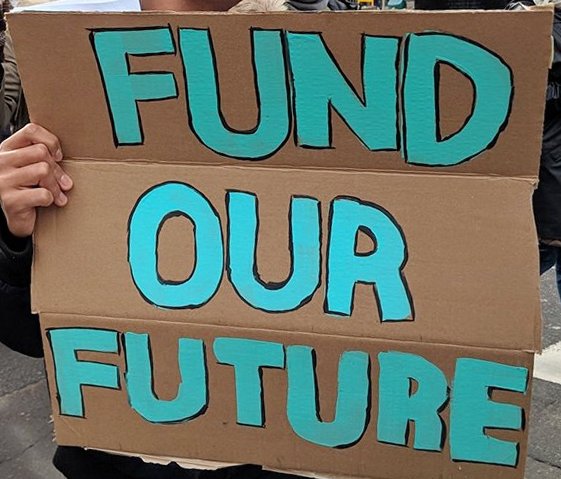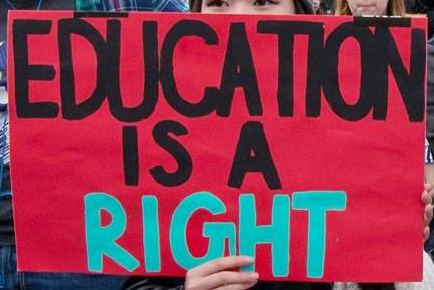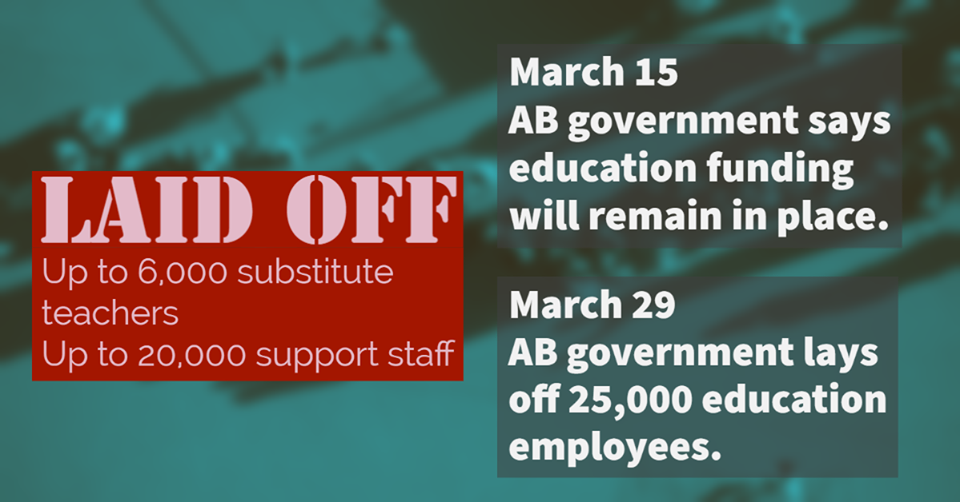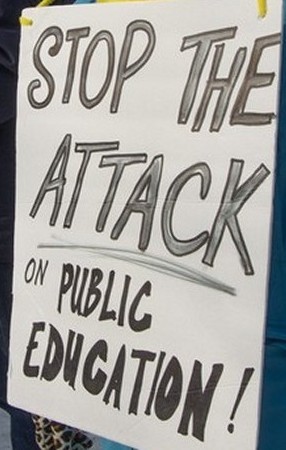|
April 2, 2020
Opposition to Use of Pandemic to Step
Up Anti-Social Offensive
Alberta Government Uses COVID-19 Pandemic
as Pretext to Cut
Education Funding
- Kevan Hunter -
 
ò Unions
Demand Government Reverse Decision to Lay Off
Education Workers
Public
Sector Workers Continue to Defend Their Rights
and the Rights of All
• Alberta Health Care
Workers Reach Agreement on Safe and Effective
Use of Personal Protective Equipment
- Peggy Morton
• Measures Taken in
British Columbia to Protect Seniors and
Workers at Long-Term Care Facilities
- Barbara Biley
• Postal Workers on the
Frontlines in Halifax
Opposition to Use of Pandemic to
Step Up Anti-Social Offensive
- Kevan Hunter -
Alberta Education Minister Adriana LaGrange
announced on March 28 that the government was
withdrawing funding for substitute teachers and
support staff including educational assistants
from all Alberta school boards for staffing
during the last two months of the 2019-2020
school year. K-12 education in Alberta is now
being provided on line.
 The government's
press release provided no information on what
funding was being withdrawn. The minister's
press secretary later stated that $128 million
is being cut from the education budget, and
"redirected" to unspecified programs to respond
to the COVID-19 pandemic. The CBC reported that
a government spokesperson said the cuts will
amount to a 14 per cent reduction to the base
instruction grant and 51 per cent to
transportation funding. The government's
press release provided no information on what
funding was being withdrawn. The minister's
press secretary later stated that $128 million
is being cut from the education budget, and
"redirected" to unspecified programs to respond
to the COVID-19 pandemic. The CBC reported that
a government spokesperson said the cuts will
amount to a 14 per cent reduction to the base
instruction grant and 51 per cent to
transportation funding.
The announcement came out just before students
and staff at many school boards (including the
largest in Calgary and Edmonton) returned from
spring break. Over the break, boards and many
staff had been working hard to sort out what
learning will look like going forward. In some
cases, education workers had already begun
making home visits for students with significant
needs, and arranging for online learning. The
government's decision adds further shock to a
system where education workers are doing their
utmost to get their bearings and prepare to
begin on-line classes.
The staff who are affected are told that they
will qualify for the federal government's
enhanced EI program and "other support
programs," directly contradicting assurances
given by the Minister on March 15 when school
closures were announced that school funding
would be unaffected, so that staff would not be
laid off. On March 3 the government pushed
through legislation requiring school boards to
get provincial government approval to use
reserve funds, removing this option from school
boards.
The decision was taken with no consultation
with the unions and school boards. The press
release stated that no funding will be provided
to school boards for substitute teachers. How
will students continue to receive their
education if their teacher becomes sick and is
unable to work, even from home? Will their
classes simply be cancelled? Does the Minister
consider children with special needs expendable
and unworthy of the supports they need? When
there are so many unmet needs in this crisis,
the government is recklessly squandering
valuable resources. For example, school bus
drivers could be redeployed to bring groceries,
meals and other necessities to those who must
isolate at home.
 The utter
callousness of the government's decision to cut
funding is underscored by the fact that the
education minister does not even know how many
people are losing their jobs or what they do.
Edmonton Public Schools board chair Trisha
Estabrooks stated that even the school boards do
not know the exact impact of these funding cuts.
"There was a need for many, many such staff that
will be affected by this decision today that we
had planned for. We need them," she said. The utter
callousness of the government's decision to cut
funding is underscored by the fact that the
education minister does not even know how many
people are losing their jobs or what they do.
Edmonton Public Schools board chair Trisha
Estabrooks stated that even the school boards do
not know the exact impact of these funding cuts.
"There was a need for many, many such staff that
will be affected by this decision today that we
had planned for. We need them," she said.
Alberta uses a school-based funding model.
Schools receive a funding grant based on the
number of students enrolled as well as other
factors such as the number of English language
learners and students with special needs. School
principals, in consultation with teaching staff,
may decide to have larger classes with more
educational assistants, or smaller classes with
fewer additional supports. These decisions are
made by considering the needs of the students in
a particular school. The Minister of Education
appears to be both ignorant of and indifferent
to the consequences of her decisions, which are
based on declaring education workers to be a
"cost" and not a precious resource and creators
of enormous value.
To add insult to injury, school authorities
must still submit their 2020-21 budgets by the
usual date of May 31, with no administrative or
accounting support, and an unknown toll of staff
ill with COVID-19.
All layoffs must be stopped and reversed
immediately. Consultation must take place with
the unions as to how staff can be mobilized to
provide the necessary support and assistance
that the students require to keep abreast of
their course material. This includes providing
computers, software and internet access to all
students who do not have them. A government
which values the working people and the youth as
its greatest asset would easily identify ways in
which educational assistants and support staff
could be vital supports to families in a time of
crisis. For example, any educational assistants
not needed for their regular responsibilities
could be reassigned to support public health
initiatives, leveraging the connections and
relationships they already have with families to
ensure that no one is left to fend for
themselves during a time of pandemic.
Using the pandemic as a pretext to cut
education funding is unacceptable and shows that
both the Premier and the Education Minister are
unfit to govern. Teachers and support staff are
working out how to provide students with what
they need under these conditions. They are
speaking out and demanding that the government
abandon this inhuman, reckless, and
irresponsible decision at once. They are showing
in real life where decision-making power must
rest in order for decisions to be made in the
interests of the students and education workers.

Canadian Union of Provincial Employees (CUPE)
Alberta President Rory Gill estimates that up to
20,000 employees could lose their employment as
a result of the announcement that the provincial
government is withdrawing funding for substitute
teachers and support staff, including
educational assistants, to all Alberta school
boards during the last two months of the
2019-2020 school year. Gill called the move
heartless and thoughtless. "With a surprise
announcement, lacking in detail, on a Saturday
afternoon, the Kenney government has just fired
thousands of people who look after and educate
our kids," he said. Gill pointed out that
educational assistants [EAs] may have to seek
employment elsewhere. "You can't just fire
thousands of educational assistants and expect
them to all run back to the system in the fall,"
said Gill. "This is a recipe for a massive brain
drain."
 Since March 13
when schools were closed, support staff have
been active in providing support for students,
assisting with the many administrative tasks
associated with the sudden decision to close
schools, as well as connecting with students
with whom they have built relationships over the
course of the school year as well as years past
in some cases. Since March 13
when schools were closed, support staff have
been active in providing support for students,
assisting with the many administrative tasks
associated with the sudden decision to close
schools, as well as connecting with students
with whom they have built relationships over the
course of the school year as well as years past
in some cases.
Alberta Teachers' Association President Jason
Schilling pointed out: "Education assistants and
other staff that work in schools are really key
right now because they are providing support to
students and teachers, and ultimately parents,
with the delivery of education. We have a bunch
of kids out there who don't have access to
technology and so assistants and other school
staff are providing support with those
students," he said.
John Vradenburgh, President of CUPE Local 474
which represents custodial support staff at
Edmonton Public Schools told Workers' Forum,
"We don't know specifics for our staff group as
of today. The government does understand that it
would be prudent to have support staff assist
with a new and untested method of remote
delivery of education, yet, under the cloak of a
pandemic, they are furthering their overall plan
to dismantle public services. For today, that's
in the education sector. With 15 minutes notice
to education boards, and in a press release to
the public on a Saturday, this government has
shown how little regard they have for working
people and our public education system. Any
economist will state that people working is what
drives the economy. We've heard reports of $128
million cuts across the province, this
represents less than a quarter of a percent of
the Alberta government's yearly expenditures,
yet will so profoundly effect so many people. In
a pandemic."
Vradenburgh pointed out that the government has
missed an opportunity to provide a more thorough
cleaning of the schools than has been done in a
long time, and that in any case a pandemic
response will require more time to clean the
schools, not less.
Wilma Ellenburgh, President of Unifor Local 52A
which represents educational support staff for
Edmonton Catholic Schools told Workers'
Forum, "This decision by the Kenney
government to pull funding shows that there was
no reflection on the impact to students,
families, and the Albertans who support them.
Educational assistants [EAs] would have
continued to work until the end of the school
year, so that children with special needs would
be able to continue their school, as other kids
are doing.
 "Two weeks ago we
were prepared to have members work until the end
of June as per the advisement of the Education
Minister. I was asked to form an ad hoc
group to brainstorm for ideas on how EA's could
provide support from home to the students. This
will now fall on the certified staff to ensure
the program is delivered to all students.
However it is important to remember many of
these special needs students rely and confide
with the EA they work with. The relationship is
very different than with the teacher. I can't
figure out how the divisions are going to
manage. Next school year will probably see a
sharp cut in funding." "Two weeks ago we
were prepared to have members work until the end
of June as per the advisement of the Education
Minister. I was asked to form an ad hoc
group to brainstorm for ideas on how EA's could
provide support from home to the students. This
will now fall on the certified staff to ensure
the program is delivered to all students.
However it is important to remember many of
these special needs students rely and confide
with the EA they work with. The relationship is
very different than with the teacher. I can't
figure out how the divisions are going to
manage. Next school year will probably see a
sharp cut in funding."
Alberta Teachers' Association President Jason
Schilling said, "The Alberta government has
missed an opportunity to show leadership in a
crisis by ensuring that thousands of Albertans
have continuity of income at this very stressful
time." He said that as well as an estimated
20,000 support staff, up to 6,000 substitute
teachers would be affected.
"Today's announcement is very concerning.
Teachers and educational assistants work closely
together to facilitate student learning,"
Schilling said. "Their work was still being
utilized to support students in need of
accommodations and those with inadequate access
to technology. We continue to have concerns
about how students with special needs will be
supported through this time -- many parents are
struggling and need as much help as possible."
Schilling pointed out that many substitute
teachers work nearly full-time.
Edmonton Public School Board Trustee Bridget
Sterling tweeted to Education Minister LaGrange:
"This is incredibly cruel. The federal
government has directed employers to keep people
working whenever possible. Even your government
has asked the same. And yet you are putting
thousands of workers onto aid programs at a time
when they need their government the most."

Public Sector Workers Continue
to Defend Their Rights and the Rights of All
- Peggy Morton -

Alberta Health Services (AHS), the Alberta
Union of Provincial Employees (AUPE), Covenant
Health (CH), the Health Sciences Association of
Alberta (HSAA), and United Nurses of Alberta
(UNA) reached a joint agreement on the safe and
effective use of personal protective equipment
(PPE) in response to the COVID-19 pandemic on
March 27.
The agreement requires that a risk assessment
must be conducted for every patient interaction
to ensure front-line health care workers have
the specific personal protective equipment (PPE)
they need. "As partners in the response to
COVID-19, we trust our front-line health care
teams to make appropriate and clinically sound
decisions," the agreement states.
"Employers and unions share the common goal of
protecting the health and safety of health care
workers. During the current COVID-19 pandemic,
it is critical that the appropriate steps are
taken to protect the health and safety of all
health care workers while they provide high
quality care to Albertans and prevent exposure
to and transmission of COVID-19. It is critical
to ensure that appropriate PPE is used by all
staff and physicians, while also preserving
supplies of specialized equipment for when they
are required to provide care safely."
The unions brought forward many concerns
regarding the proper standard for PPE. Of
particular concern has been the reluctance of
the AHS to provide fit-tested N95 respirators
when required. The Canadian Federation of Nurses
Unions (CFNU) established that health care
workers taking nasal swabs from patients with
known or suspected cases of COVID-19 should
perform a point-of-care risk assessment. If the
assessment indicates the need for respiratory
protection, a fit-tested N95 respirator as a
minimum must be worn." AHS had responded to the
UNA's demand that this standard be upheld with a
completely arbitrary response saying that a
fit-tested N95 was not necessary.
The agreements also specifies that the AHS and
Covenant Health and the unions will work
together to assess the supply of PPE, and the
employers will continue to take action to ensure
an adequate supply.
Congratulations to UNA, HSAA and AUPE and all
the health care workers who actively defended
their rights and succeeded in ensuring that
proper PPE protection is in place. AHS and
Covenant Care have acknowledged in the agreement
that front-line staff are the ones competent to
make appropriate and clinically sound decisions.
This was the case before the current COVID-19
crisis, it is the case during the crisis and
will be after the crisis.
The COVID-19 pandemic will continue to reveal
why decision-making power belongs in the hands
of health care workers and their collectives.
They have shown they are the ones competent to
make decisions, based on what is needed to allow
them to do their work safely and protect their
health and that of their patients.

- Barbara Biley -

Comox Valley meeting on the crisis in seniors
care, February 24, 2020.
Under the Emergency Program Act that
was invoked by the government of British
Columbia on March 26, the Provincial Health
Officer Bonnie Henry issued an emergency order
restricting long-term care workers to a single
site. The purpose of the order is to minimize
the possibility of spread of the COVID-19 virus
by care workers who work in more than one
long-term care facility for seniors.
The first cases and the greatest number of
deaths from COVID-19 in British Columbia have
occurred at the Lynn Valley Care Centre in North
Vancouver. As of March 26, 46 residents and 24
staff have tested positive and 11 residents have
died at this home. There are outbreaks affecting
seniors and workers in more than 10 other care
homes in British Columbia and both Ontario and
Quebec have reported outbreaks in long-term care
homes.
The Lynn Valley Care Centre is illustrative of
the problems that exist in long-term care,
particularly in the homes owned and operated by
private companies and not the Health
Authorities. The owners of the Lynn Valley Care
Centre subcontract work so there are three
separate employers at the facility. Only the
nurses are represented by a union. As is the
case throughout the province, many of the
workers are part-time or casual and work in more
than one facility, increasing the possibility of
transmission of COVID-19 and any other
communicable disease to seniors from one home to
another. Wages and working conditions in the
homes owned and operated by the Health
Authorities and some of the
not-for-private-profit homes are the same
throughout the province, part of two "master
agreements," the Facilities Collective Agreement
(covering workers other than nurses) and the
Nurses Collective Agreement. Workers are
organized and represented by unions, mainly the
Hospital Employees' Union and the BC Government
and Service Employees' Union, in many of the
privately-owned homes but wages and working
conditions are substantially lower than those in
the two master agreements.
In collaboration with the unions, a plan was
worked out to facilitate the restriction of
workers in long-term care to working in only one
facility during the COVID-19 pandemic in such a
way that the province takes responsibility for
ensuring adequate staffing levels and workers'
jobs are protected. All employers were required
to submit "personal and employment related
information of staff including their name,
contact information, social insurance number and
other information" in electronic form to the
Provincial Health Officer by midnight, March 28.
Some, if not all, aspects of staffing for all
facilities will be centralized in order to
ensure adequate levels and be the responsibility
of the government. Workers have to choose which
facility they will work at and their jobs will
be protected at the facilities they have not
chosen. Workers will be guaranteed the same
number of hours of work at the chosen facility
as they currently work at multiple facilities if
they wish to work the same number of hours.
This is a measure that will greatly strengthen
the protection of seniors and the workers who
care for them. It is unclear whether the same
measures apply to other situations, including
group homes for people with disabilities. It is
clear that there are other crisis points in the
health care system, including home care where
workers go to the homes of several vulnerable
people in the course of a day, and the needs of
seniors and people with disabilities that hire
and manage their personal care staff with funds
from the Health Authorities.
The unions representing health care workers
have been involved in the discussions that
preceded the orders and will continue to be
involved in the implementation.

Jim Gallant, a regional grievance officer for
the Canadian Union of Postal Workers, Atlantic
Region expressed the concern of postal workers
in Nova Scotia about the dangers they're facing
as they continue working through this pandemic.
In an interview with the Halifax Examiner published
on
March 25, 2020, Gallant said that many postal
workers in the province are concerned about not
having continuous access to the necessary tools
to do their jobs, including nitrile gloves or
hand sanitizer. He also expressed concerns about
the level of cleanliness or lack thereof, at the
two main plants on Allman Street in Halifax and
in the Burnside industrial park. Although there
are regular complaints to Canada Post about the
need for a deep cleaning, Gallant said, during
this pandemic the need is far more urgent.
 Gallant said,
"it's one thing when there's dust around and
people have asthma and different things like
that, but when this is around and you can see
dust that has been sitting there for a month or
two months or 10 months, what happens if
COVID-19 is on the floor?" He went on to say,"
and it's not just on the floor. It's on
sortation cases. You can see the dust that's
been sitting there and it's not moving, so
that's the fear." Gallant said,
"it's one thing when there's dust around and
people have asthma and different things like
that, but when this is around and you can see
dust that has been sitting there for a month or
two months or 10 months, what happens if
COVID-19 is on the floor?" He went on to say,"
and it's not just on the floor. It's on
sortation cases. You can see the dust that's
been sitting there and it's not moving, so
that's the fear."
Gallant said that while Canada Post has assured
the Union about the deep cleaning of the
warehouse, "it hasn't yet happened."
In his interview Gallant wanted to thank the
vast majority of customers for their support. He
encouraged people to help keep postal workers
safe by maintaining an adequate distance from
them as they deliver mail and parcels. Whether
it is at the community mailbox or in an
apartment building lobby, he said people should
remain at a distance of two metres or more.
"The vast majority of the workers want to go to
work and get their jobs done. It's a matter of
pride that we are postal workers and we always
deliver," Gallant said.

(To access articles
individually click on the black headline.)
PDF
PREVIOUS ISSUES
| HOME
Website: www.cpcml.ca
Email: office@cpcml.ca
|

